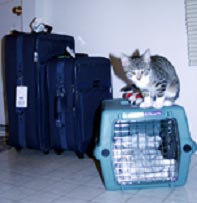Will
my cat be upset by the move?
Some
cats seem to take moving in
their stride, but for others
the loss of their familiar territory
can be very traumatic and settling
in to the new home can pose
problems for owners and cats
alike. Cats are territorial
creatures and when your cat
is the new kid on the block
it may find itself being less
than welcomed by the local feline
residents. Cats that are kept
entirely indoors may adapt more
easily to a new home, since
their territory still contains
familiar people, animals and
objects, and integration into
an existing feline population
is not an issue. However, indoor
cats can develop behavioral
problems following a house move
and whether your cat lives indoors
or out, the way in which you
prepare it for the
move and deal with the first
few days in the new home can
be very important.

Preparing
for the move
Feline
territory is divided into three
main zones: the core, the home
range and the hunting range.
The core territory is where
the cat eats, sleeps and plays
and in the wild this area is
very stable and secure. For
the domestic cat the core territory
is usually represented by the
house, although for some cats
it may be smaller and consist
of one or two rooms within the
house, and disruption within
this area can be very distressing.
Minimizing changes and upheaval
within the core territory is
important and when you are preparing
for the house move it may be
advisable to keep the boxes
and suitcases out of view so
that the home remains as constant
as possible for your cat. Obviously
there comes a point where the
packing cannot be hidden. At
this point, if your cat seems
overly anxious or if conflict
induced behavior problems (such
as excessive grooming or urine
marking) begin to emerge then
it might be best to put your
cat in a kennel, rather than
allow it to watch the dismantling
of its territory.
How
should I introduce my cat to
the new house?
Once
you have moved into your new
home it is advisable to wait
until at least one room in the
house is completely unpacked
before bringing your cat into
the house. This ensures that
the environment that your cat
comes into is as stable as possible.
Restricting the cat's
access to the rooms where the
unpacking has been finished
is a sensible precaution, since
the packing boxes and suitcases
are likely to be a symbol of
disruption and signal to your
cat that this new environment
is less than secure. Introducing
your cat to one room at a time
will also prevent problems of
overwhelming it with too much
new territory too quickly. Therefore,
even if you are a very efficient
unpacker and have all of your
rooms up and running within
days, it can still be beneficial
to restrict access to one or
two rooms for the first few
days.
Using
scent signals
One
of the ways in which you can
increase your cat's acceptance
of its new territory is to make
it as familiar as possible.
The first room you place your
cat into should perhaps be one
that will have some furniture
that is familiar to the cat
from the previous home. Putting
your cat's bedding and
food bowls from the old house
into the room should also help.
In addition you may find it
beneficial to a synthetic feline
facial scent, to the room. This
product, which is available
from your veterinarian, acts
to make the environment appear
familiar to your cat and will
help it to settle in. It would
be sensible to apply the product
to the room at least 30 minutes
before your cat goes inside
and to top up the scent profile
by applying the product once
a day for the first week. As
you expand your cat's
territory within the home by
giving it access to more and
more rooms you should use the
product in each new area.
How
long will my cat take to settle
in at the new house?
There
is no easy answer to this question
as every cat is an individual
and will react differently to
the challenge of a new home.
Most cats start to relax within
a few days of moving, but there
are others that take weeks to
adjust to their new environment.
One of the most important coping
strategies for cats when they
face a new challenge is hiding
and it
 is
important to resist the temptation
to bring your cat out from his
hiding places. It can be distressing
for owners to see their cat
huddled on the top of a dresser
or peering out from under the
table, but you need to give
your cat the opportunity to
observe its new home from a
safe vantage point and to come
to terms with the changes in
its own time. Forcing cats to
come out to meet the world (or
to do anything for that matter)
can seriously back fire and
make the settling in process
far more drawn out in the long
run. Obviously if your cat shows
no signs of adjusting, or if
it refuses to eat for more than
a couple of days, you will need
to take action and you should
consult your veterinarian for
advice. The aim is to encourage
your cat to come down from his
safe haven. Work to make the
home more attractive in feline
terms using tasty food treats
and special play to fulfill
the cat's need for affection
or attention. However, it is
important to remember that cats
need to feel in control and
the treats or games should not
be forced on the pet. Instead
they should be provided as soon
as the cat voluntarily displays
any small progress (baby steps). is
important to resist the temptation
to bring your cat out from his
hiding places. It can be distressing
for owners to see their cat
huddled on the top of a dresser
or peering out from under the
table, but you need to give
your cat the opportunity to
observe its new home from a
safe vantage point and to come
to terms with the changes in
its own time. Forcing cats to
come out to meet the world (or
to do anything for that matter)
can seriously back fire and
make the settling in process
far more drawn out in the long
run. Obviously if your cat shows
no signs of adjusting, or if
it refuses to eat for more than
a couple of days, you will need
to take action and you should
consult your veterinarian for
advice. The aim is to encourage
your cat to come down from his
safe haven. Work to make the
home more attractive in feline
terms using tasty food treats
and special play to fulfill
the cat's need for affection
or attention. However, it is
important to remember that cats
need to feel in control and
the treats or games should not
be forced on the pet. Instead
they should be provided as soon
as the cat voluntarily displays
any small progress (baby steps).
When
can I let my cat out into the
yard?
For
owners of cats that go outside
one of the hardest decisions
to make after moving is when,
if ever to open the door and
let the cat out! There are a
number of myths concerning this
subject and various techniques
have been suggested as ways
of ensuring that the cat comes
home again, such as putting
butter on the cat's paws,!
Cats live in a scent-orientated
world and they find their way
from place to place by following
scent gradients. This means
that your cat will return home
to where his scent signal is
strongest provided there is
no strong fear or anxiety associated
with the new home. Therefore
the practice of restricting
your pet to the new home for
a couple of weeks makes perfect
sense. By staying inside the
house for this period your cat
will build up a strong scent
presence and any fear or apprehension
about the new household will
have diminished or disappeared.
Then when the cat eventually
ventures outside, there will
be a significant scent gradient
to follow back to the house
and no feelings of avoidance.
A feline facial scent can also
be used to assist in the forming
of a stable scent profile and
some sources suggest that it
encourages cats to return to
their new home, so that the
amount of time your cat needs
to be kept confined before letting
it out for the first time can
be decreased. It can help to
give the first taste of freedom
at a time when the cat is most
likely to stay close at hand
and waiting until just before
mealtime can be a sensible approach.
With the prospect of a meal
looming your cat should be eager
to stay near to the house and
if you call it in for dinner
just a few minutes after letting
it out, you will be reinforcing
the behavior of coming home.
What
can I do to stop my cat from
returning to my old house?
When
owners move relatively short
distances, one of the most common
problems that they face is their
cat returning to the old house.
There are numerous tales of
cats walking significant distances
to get back to their old home
and while some go straight to
the house and demand to be let
in, others seem content to sit
in their old garden or wander
round their old hunting ground.
There are two possible approaches
to this problem. Firstly, to
increase the attraction of the
new home, in feline terms, and
secondly to decrease the reward
associated with the old home.
It
is possible to increase the
bond to the new house and yard
by ensuring that positive associations
are made in the form of provision
of valuable resources. Working
to ensure that food, shelter,
affection, and
 privacy
are available in abundant supply
will help to maintain the cat's
interest in its home. However,
the way in which these resources
are offered is important and
owners need to guard against
being too overpowering with
their pets. Too much human intervention
in the form of oppressive affection
and high levels of owner initiated
contact may be too much for
some cats and are likely to
increase the likelihood of avoidance.
In that case adopting an off
hand attitude, that leaves the
cat asking for more attention
and affection, will be far more
effective. Games with a fishing
rod toy can be very helpful
as they give you the opportunity
to interact with your cat while
still allowing it to engage
in some independent play. Offering
food treats without trying to
make any direct interaction
can be another way of rewarding
your cat for staying home while
allowing it to feel in control. privacy
are available in abundant supply
will help to maintain the cat's
interest in its home. However,
the way in which these resources
are offered is important and
owners need to guard against
being too overpowering with
their pets. Too much human intervention
in the form of oppressive affection
and high levels of owner initiated
contact may be too much for
some cats and are likely to
increase the likelihood of avoidance.
In that case adopting an off
hand attitude, that leaves the
cat asking for more attention
and affection, will be far more
effective. Games with a fishing
rod toy can be very helpful
as they give you the opportunity
to interact with your cat while
still allowing it to engage
in some independent play. Offering
food treats without trying to
make any direct interaction
can be another way of rewarding
your cat for staying home while
allowing it to feel in control.
Decreasing
the value associated with the
old stomping ground can be a
little more difficult, especially
for a cat that is an efficient
hunter! If the old patch had
a good supply of prey, and the
cat was frequently rewarded
on its hunting expeditions,
it can be very hard to convince
the cat that returning "home"
is not a good idea. However,
if the reward appears to be
strongly associated with the
house, and with the warmth,
comfort and security it offers,
things can be a little more
straightforward. Co-operation
with the new occupants is essential,
since they need to work to make
the old home less appealing,
and this is usually much easier
if they are not particularly
fond of cats! Making sure that
there is no food available when
the cat returns and using hostile
interactions with sounds and
water or avoidance devices (see
our handout on ‘Behaviour
management products')
can help to make the old place
much less appealing. This may
sound simple but it is important
that the hostility is consistent
and is not simply connected
with the new inhabitants, because
cats can very quickly learn
to only come by when the new
people are out! Equally any
hostility must not be harmful
and people need to be prepared
to use their brains as well
as their brawn when trying to
outwit a cat.
Obviously
a combination of these two approaches
will offer the very best chance
of keeping the cat at the new
house.
Will
there be problems with other
cats in the neighborhood?
One
of the major concerns for owners
of outdoor cats is the potential
conflict from other cats in
the new neighborhood. It is
certainly true that newcomers
are not made particularly welcome
in the feline world, but one
of the most significant effects
of neutering on feline behavior
is to decrease hostility to
outsiders. In an urban area
where most of the cat population
is neutered this certainly helps.
Integration into the local population
is largely a feline matter and
there is little that owners
can do to smooth the process,
but it can be helpful to talk
to other cat owners in the area
and work out a time share system
for the first week or so. This
enables the newcomer to explore
the neighborhood without risk
of attack and to leave some
scent signals for the resident
cats to read. Such indirect
communication can smooth the
way for the first face-to-face
encounters since the incoming
cat has a familiar scent.
This client
information sheet is based on
material written by Debra Horwitz,
DVM, DACVB and
Gary Landsberg, DVM, DACVB.
© Copyright 2002 Lifelearn
Inc. Used with permission under
license. March 11, 2004. |